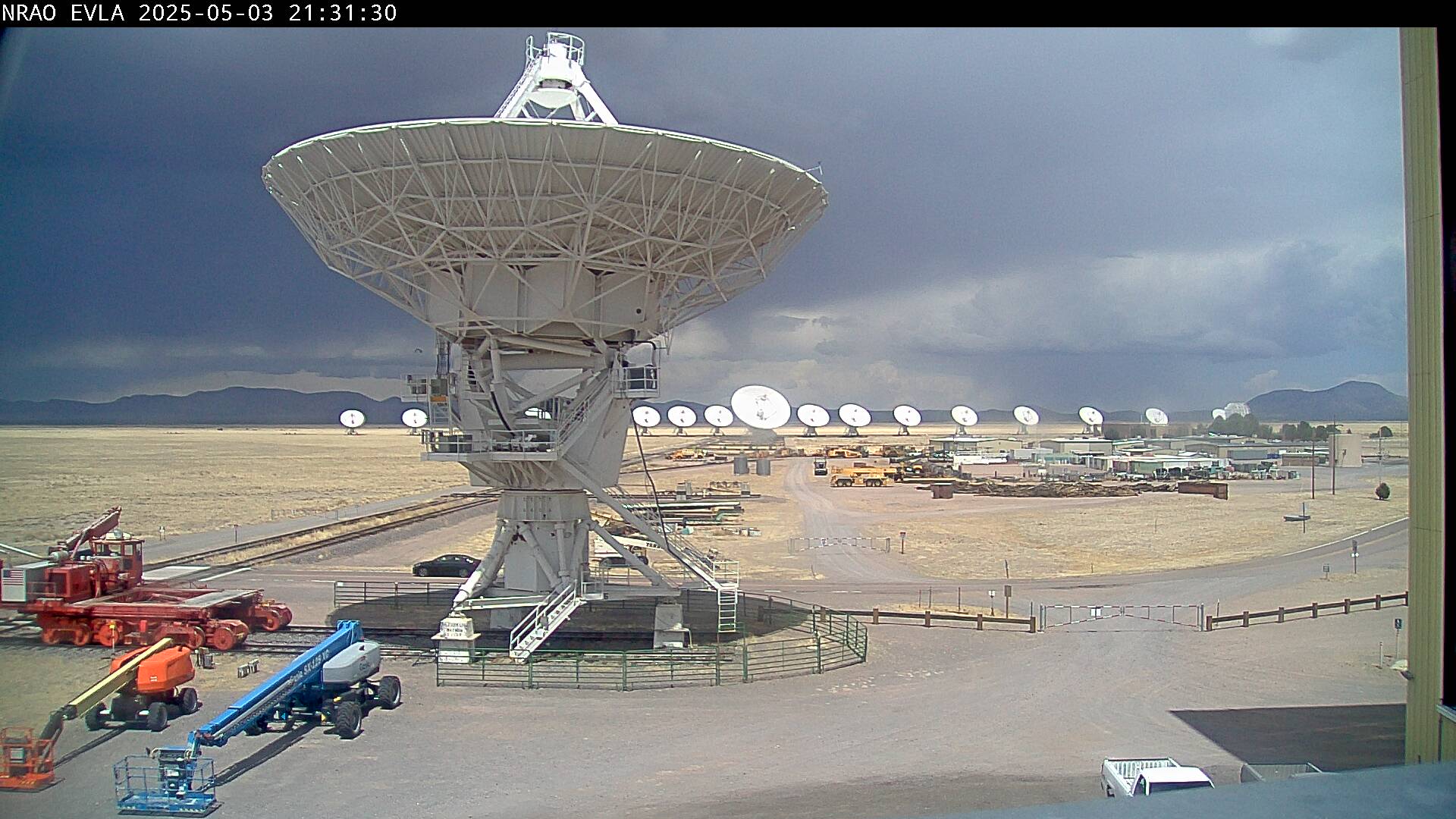Very Large Array (Magdalena), NM Weather Cams
Very Large Array NRAO EVLA Cam

A Giant Ear to the Cosmos: The Story of the Very Large Array
Very Large Array (Magdalena), NM Weather Cams. The Very Large Array (VLA) in Magdalena, New Mexico, is more than just an array of antennas – it’s a testament to human ingenuity and a window into the universe. From its inception to its ongoing discoveries, the VLA’s story is intricately woven with the history of radio astronomy and its relentless pursuit of unraveling the secrets of the cosmos.
From the Cold War to the Cosmos: The VLA’s Origins
The seeds for the VLA were sown in the late 1960s, a time marked by the Cold War and the space race. These geopolitical tensions fueled a surge in radio astronomy research, as the technology found applications in both scientific exploration and military surveillance. In 1967, the National Science Foundation (NSF) established the National Radio Astronomy Observatory (NRAO) to spearhead this research.
The NRAO’s initial focus was on building the Very Large Array, a radio telescope with unprecedented capabilities. The vision was to create a powerful instrument that could observe faint radio sources, explore the structure of galaxies, and probe the early universe. The project was met with both excitement and skepticism, as the sheer scale and complexity of the endeavor were unprecedented.
A Monument to Engineering: Construction and Design
The VLA’s construction was a monumental task. The chosen site, the San Agustin Plains in New Mexico, presented unique challenges, including high winds, extreme temperatures, and remote location. The solution lay in a revolutionary design: a Y-shaped configuration with 27 radio antennas, each 25 meters in diameter and weighing 200 tons. The antennas were arranged along three arms, each 21 kilometers long, allowing for a variety of configurations to be used for different observations.
The construction, which began in 1972, was a triumph of engineering and logistics. A complex infrastructure of roads, power lines, and communication systems was built to support the antennas and the central control room. The antennas themselves were meticulously crafted, equipped with precise pointing mechanisms and highly sensitive receivers.
A New Era in Radio Astronomy: The VLA Comes Online
The VLA officially began observations in 1980, marking a pivotal moment in the history of radio astronomy. Its unprecedented sensitivity and versatility enabled astronomers to conduct research that was previously impossible. The VLA opened new avenues of investigation, allowing scientists to study a diverse range of celestial objects, from nearby stars to distant quasars.
One of the VLA’s early triumphs was the discovery of the first binary pulsar, a system consisting of two neutron stars orbiting each other. This groundbreaking discovery, awarded the 1993 Nobel Prize in Physics, provided invaluable insight into the evolution of stars and the nature of gravity. The VLA also played a crucial role in the detection of the first extrasolar planets, confirming the existence of planetary systems beyond our own.
A Legacy of Discoveries: Expanding Our Understanding of the Universe
The VLA has been instrumental in a wide range of groundbreaking discoveries over the past four decades. Its observations have revolutionized our understanding of galaxy formation, the evolution of stars, the nature of black holes, and the distribution of matter in the universe.
The VLA has helped to map the distribution of dark matter, the elusive substance that makes up the majority of the universe’s mass. It has also been used to study the formation of supermassive black holes at the centers of galaxies, and to investigate the origins of cosmic rays, high-energy particles that bombard Earth from outer space.
The VLA has also made significant contributions to the study of our own solar system. It has been used to study the atmospheres of planets, to map the surface of Mars, and to investigate the origins of comets and asteroids. In 2019, the VLA was used to image the event horizon of a supermassive black hole, a breakthrough that earned the 2020 Nobel Prize in Physics.
Constant Evolution: Modernization and Future Prospects
The VLA has undergone several upgrades throughout its lifespan, including improvements to its receivers, signal processing capabilities, and data storage capacity. The latest upgrade, known as the EVLA (Expanded Very Large Array), involved the installation of new receivers and high-speed data links, significantly enhancing its sensitivity and resolving power.
The VLA’s future looks promising. The NSF has committed to funding future upgrades, including the development of a new generation of receivers that will enable the VLA to observe at even higher frequencies and with greater sensitivity. These upgrades will enable astronomers to delve deeper into the mysteries of the universe, pushing the boundaries of our understanding of the cosmos.
Beyond the Science: The VLA’s Impact on Society
The VLA’s impact extends far beyond scientific discoveries. It has become an iconic symbol of human ingenuity and a powerful reminder of the vastness and wonder of the universe. The VLA’s site near Magdalena, New Mexico, has attracted visitors from all over the world, inspiring countless individuals with its breathtaking views and the stories of the cosmic discoveries it has made possible.
The VLA has also played a significant role in promoting scientific literacy and education. The NRAO offers a variety of outreach programs, including tours, workshops, and educational resources, to engage the public with the wonders of astronomy. The VLA has inspired generations of scientists and engineers, showcasing the power of curiosity and the potential of human ingenuity to unlock the secrets of the universe.
A Monument to Human Curiosity: The VLA’s Enduring Legacy
The VLA’s journey from its conception to its ongoing discoveries is a testament to the power of human curiosity and the tireless pursuit of knowledge. Its design, construction, and operation represent a triumph of engineering, collaboration, and perseverance. The VLA has transformed our understanding of the universe, opening new avenues of exploration and inspiring countless individuals to embrace the wonders of the cosmos.
The VLA’s legacy is not limited to its scientific contributions; it also stands as a symbol of human ingenuity, creativity, and the enduring desire to understand our place in the universe. As we continue to explore the cosmos, the VLA will remain a powerful tool for discovery, a testament to our quest for knowledge, and a beacon of inspiration for generations to come.
